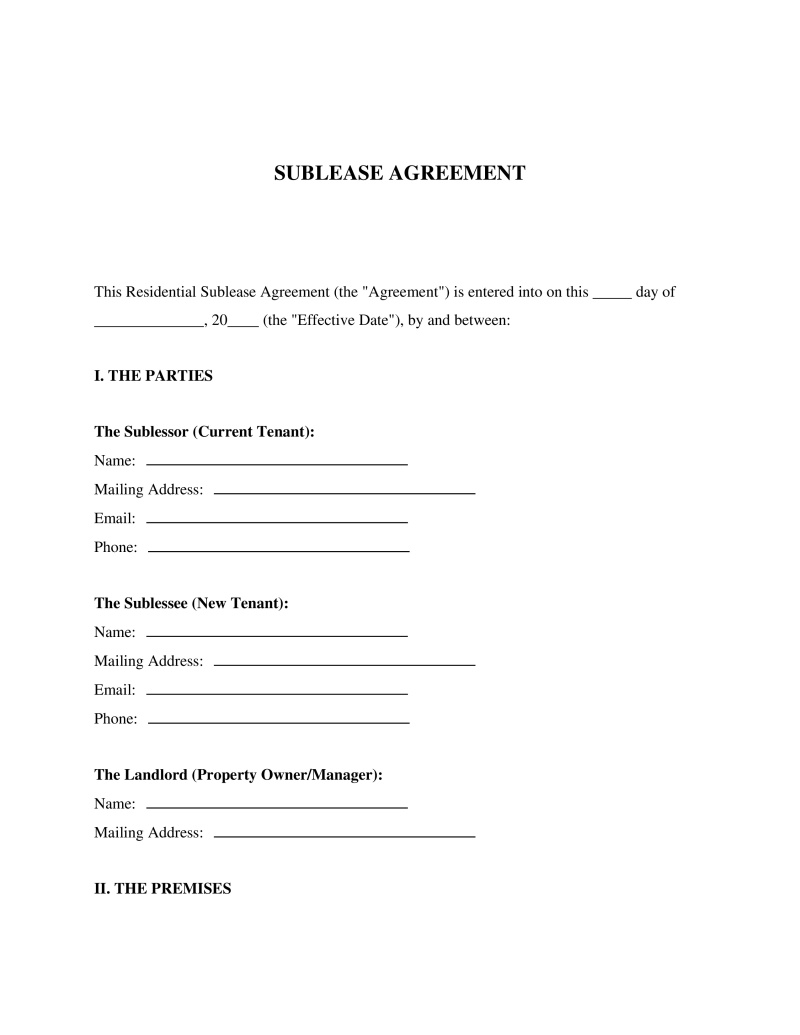A Sublease Agreement is a contract allowing a tenant to lease rented property to another party, defining terms and conditions of the sublease.
Is Entire Property Sublet
Select 'Entire property' if the subtenant will have exclusive use of the whole premises. Select 'Portion' if only part (e.g., a room) is being sublet.

Table of Contents
What is a Sublease Agreement?
A Sublease Agreement is a legally binding contract that allows a current tenant, known as the sublessor, to rent out all or part of a leased property to a new tenant, referred to as the sublessee. This document establishes a secondary tenancy structure where the original tenant effectively acts as a landlord to the new occupant while maintaining their existing contractual obligations to the property owner. This arrangement is frequently utilized in both residential and commercial real estate sectors when a tenant needs to relocate temporarily, wishes to offset rental costs by sharing space, or requires early departure before a lease term expires. The original lease, often called the master lease, remains active and dictates the permissible terms of any subsequent subletting arrangement.
The Legal Relationship Between Parties
In a standard leasing arrangement, a direct legal relationship exists between the landlord and the tenant, known as privity of estate and privity of contract. When a sublease is executed, it creates a new layer of legal responsibility without severing the original bond between the landlord and the prime tenant. The sublessor retains full liability for the condition of the property and the payment of rent to the landlord, regardless of whether the sublessee fulfills their financial obligations. Consequently, the sublessee typically has no direct legal relationship with the original landlord and must direct all maintenance requests and rent payments to the sublessor, unless a specific agreement states otherwise.
Sublease vs. Lease Assignment
It is distinctively important to differentiate between a sublease and a lease assignment, as they carry different legal implications regarding liability and property interest. In an assignment, the original tenant transfers their entire remaining interest in the property to a new tenant and permanently vacates the premises. Depending on state laws and the specific terms of the release, an assignment often relieves the original tenant of future financial liability. Conversely, a sublease involves the transfer of less than the tenant's full interest, meaning the original tenant retains a reversionary interest and plans to retake possession or remains liable until the lease expires. The sublessor acts as a middleman, bearing the risk of the sublessee's default.
Essential Elements of a Sublease Agreement
To ensure enforceability and clarity, a comprehensive document must address specific terms that mirror and comply with the master lease. Missing elements can lead to disputes regarding security deposits, utility payments, or eviction procedures.
- Parties Involved: Full legal names of the sublessor (original tenant) and the sublessee (new tenant).
- Premises Description: Detailed address of the property, including specific notes if only a portion (such as one room in an apartment) is being rented.
- Term of Sublease: The start and end dates of the arrangement, which cannot exceed the end date of the master lease.
- Rent and Utilities: The amount of rent, due date, acceptable payment methods, and division of utility costs.
- Security Deposit: The amount required, conditions for deductions, and the timeline for return following the sublessee's departure.
- Master Lease Adherence: A clause stating the sublessee has received a copy of the original lease and agrees to abide by its rules and regulations.
- Signatures: Dated signatures of the sublessor, sublessee, and often the landlord, acknowledging consent.
Statutory Regulations and Landlord Consent
The validity of a Sublease Agreement is heavily dependent on state statutes and the specific provisions contained within the master lease. In the United States, the Uniform Residential Landlord and Tenant Act (URLTA) influences many state laws, but specific regulations vary significantly by jurisdiction. For example, under New York Real Property Law Section 226-b, tenants in buildings with four or more units generally have the right to sublease, and landlords cannot unreasonably withhold consent. Conversely, in states like Texas, the Property Code prohibits subletting unless the landlord explicitly provides prior written consent.
Federal laws also play a role, particularly regarding discrimination. The Fair Housing Act prohibits sublessors from discriminating against potential sublessees based on race, color, national origin, religion, sex, familial status, or disability. While the sublessor is acting as a landlord, they must adhere to these federal anti-discrimination standards during the tenant screening process. Furthermore, failure to obtain required landlord consent can result in a material breach of the master lease, potentially leading to eviction proceedings against both the sublessor and the sublessee.
Frequently Asked Questions
Do you have a question about a Sublease Agreement?
Example questions:
Not the form you're looking for?
Try our legal document generator to create a custom document
Community Discussion
Share your experience and help others
Legal Notice: Comments are personal opinions and do not constitute legal advice. Always consult a qualified attorney for matters specific to your situation.
Comments (0)
Leave a Comment
No comments yet. Be the first to comment!